
The Jamboree music was composed by Greek Academy Award-winning composer Manos Hatzidakis while the lyrics to the original version in Greek, were by the famous Greek lyricist Nikos Gatsos. The song, with vocals sung by the Boy's Chorus of the Chapel of the Greek Royal Palace, circulated as an 45 RPM Jamboree record back in 1963, under the Columbia label (code SCDG 3315). This song was heard every morning at reveille; 14 thousand scouts used to wake up daily to this music. The record featured the song "I Fotia" (greek for The Fire), on side B.
There were at least three official international versions of the song, in English, in Italian and in French language. The French version was discovered in 2023, on the occasion of the 60th Anniversary and is included below. It is unknown which of the two Italian Scout Associations which participated in the Jamboree, ASCI or CNGFI, introduced the italian song, probably it was common for both.
Apart from the Greek record there was also a Dutch-cut 45RPM record, again by Columbia, with a much more elaborate cover featuring the Marathon Courier on yellow background (code CH 3038).
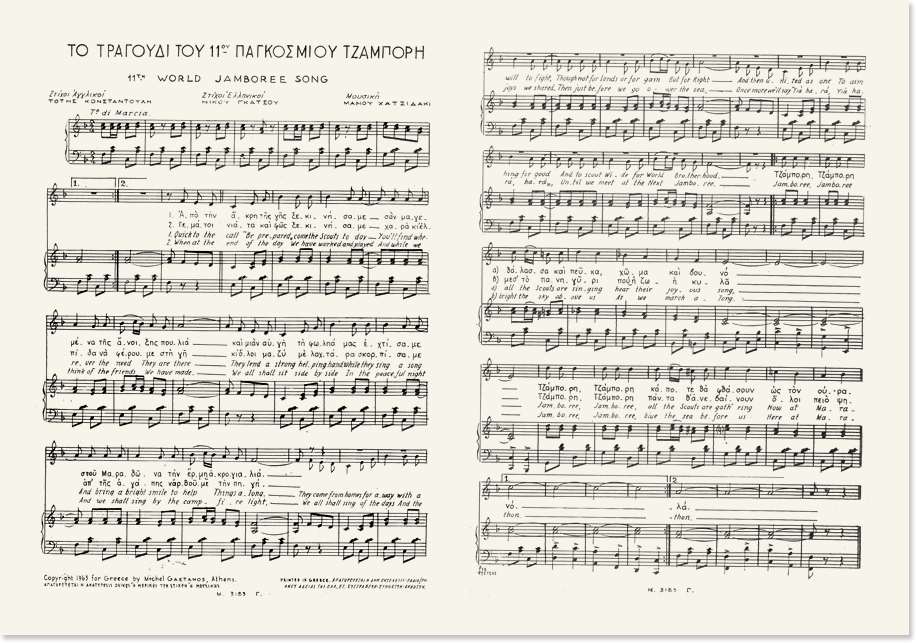

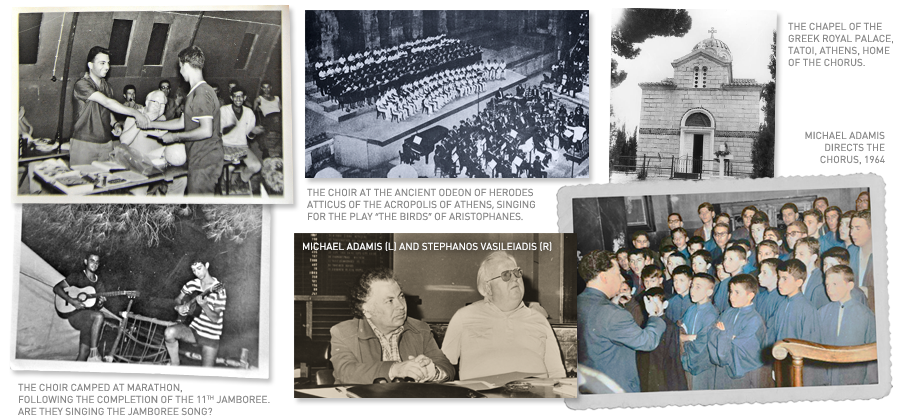
The Chorus was founded in the autumn of 1949 by King Paul of Greece, by order of which, its creation and management was entrusted, by the then archpriest of the Palace, Father Ieronymos Kotsonis (later Archbishop Ieronymos I, Primate of the Church of Greece 1967-1973) to musical up-and-comer Michalis Adamis. His remarkably young age of 20, at the time he was called upon to lead the venture on behalf of the Royal Palace, was characteristic of his musical talent and potential.
It is worth noting that the first Greek palace choir was founded in 1870 by Alexandros Katakouzinos, based on the desire of the music-loving Queen Olga, who was the one who brought polyphony to Greece. From 1950 to 1967, when Greek Monarchy was abolished, the Chorus was the exclusive musical frame of the Chapel of the Greek Royal Palace, covering almost the entire cycle of services in the church calendar.
The systematic broadcasting of the Sunday Liturgy on Greek national radio made the Chorus widely known throughout Greece and extremely popular. It consisted of boys aged 8 to 14 (soprano - alto), who were chosen from the schools of the Athens Region and were supported by heavier male voices, mainly university students and young men (tenoro - basso). For its beginning, the chorus was staffed with the children of the choir of the Christian Student Groups, the school youth of the Christian Orthodox organization "Zoe Brotherhood".
It numbered an average of about 80 choristers, while it is estimated that during its 18 years of activity, more than 700 children in total, acted as members. During the school year, the Chorus rehearsed twice a week, while intensive work of group vocal practice and preparation for the new year took place at their open-air summer camp, which were held at the Greek Royal Palace estate in Tatoi, Athens, during a period that the chapel was not operating due to the absence of the royal family on summer holidays.
Almost the same age as Manos Hadjidakis, Adamis was his personal friend and classmate in the music schools of the time. Hadjidakis often used the Boys’ Chorus of the Royal Chapel in his musical works. The most renowned case was their participation in his ingenious original musical work for the legendary performance of the Art Theater, "The Birds” (Les Oiseaux, Ornithes) by Aristophanes, which was presented at the prestigious ancient Odeon of Herodes Atticus at the Acropolis of Athens, in the summer of 1959. The play was directed by prominent Greek theater director Karolos Koun, sets and costumes by Greek modernist painter and set designer of international fame Yiannis Tsarouchis and choreography by Rallou Manou. A couple of year later, in 1962, Koun’s “The Birds” won first prize at the international festival of Paris. It is said that no show in Greece caused as much upheaval as “The Birds”, while the music of no other play traveled farther and more melodically through time (link to article in greek language).
For a period of 4 years, from 1961 to 1965, the Chorus was directed by the distinguished contemporary composer and music educator Stefanos Vassiliadis (1933-2004), who replaced M. Adamis during his absence in Boston, USA for advanced musical studies in the composition of electronic music and in Byzantine Paleography, at Brandeis University. Vassiliadis was hence directing the Chorus in the year 1963, when the boys sang the Song of the 11th World Jamboree, to the melody of cheerful Manos Hadjidakis and the lyrics of Nikos Gatsos. Legendary names of world-class artists, the best that Greece has to show throughout time, crossed their paths with the Greek scouting movement and offered their prestige. The song was recorded in the presence and musical direction of Hadjidakis at the Columbia studios in Rizoupoli, Athens, while the Chorus attended and sang the Song live, under the direction of Vassiliadis, at the Opening Ceremony of the Jamboree, in the outdoor amphitheater in Marathon, on the evening of August 1, 1963. After the end of the Jamboree, the Chorus had the unique opportunity to hold their multi-day camp of that year, in the empty premises of Marathon.
The Boy’s Chorus of the Chapel of the Greek Royal Palace was the first important children's choir in Greece. It created a tradition, opened new paths in the field of choral performance and was the nucleus from which other similar efforts began. The melodious voices of the Chorus’ Boys went down in history through the 5 vinyl media they recorded, including “The Birds” and of course the Jamboree Song. The latter may have been a short stop in the long and important course of the Chorus, an act that was unplanned and of “last moment” type, but 60 years later, the tone of their voices remains indelible in the collective memory of thousands of Scouts and non-Scouts, in Greece and around the world, through the inspired words of Nikos that strike uniquely with the allegro marching melody of Manos:
Apo tin akri tis gis xekinisame
(We set off from the edge of the world)
sa magemena tin anixis pulia
(like spellbound spring birds)
kai mian avgi ti folia mas estisame
(and, one dawn, we build our nest)
stou Marathona tin erimi akrogialia…
(at Marathon’s deserted waterside…)

After many years of searching for the ultra-rare English version of the 11th WSJ song, we are delighted to have finally got hold of it and present it to the world. We hope you enjoy it.
Added August 10, 2023
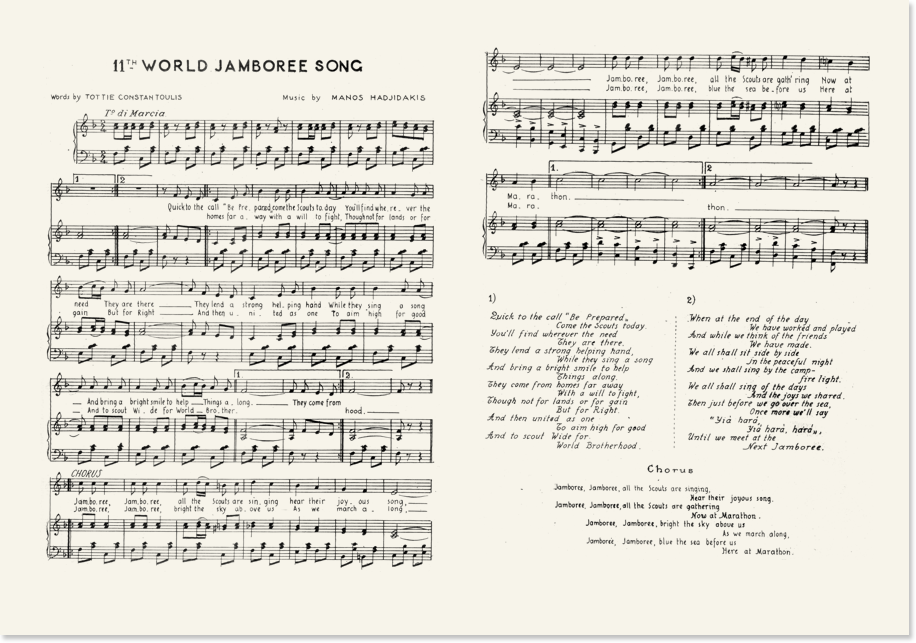
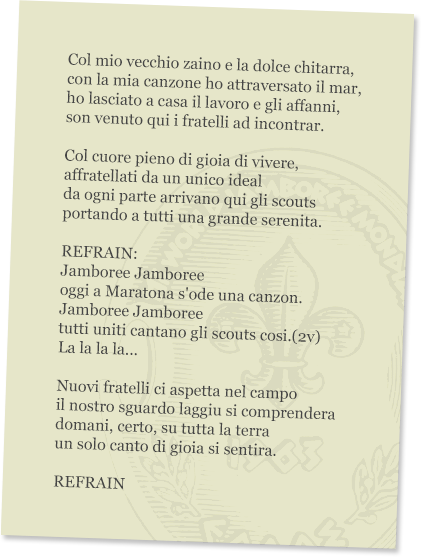

The french lyrics were made by François Lebouteux, executive of the French National Education, graduate of the École Normale Supérieure and National Leader of the Scouts de France from 1956 to 1964. He was at the epicenter of a profound reform of the french scout movement in the 1960s where, as an academy inspector, he helped assert the place of national education in scout training. At the same time, he led important missions in terms of international cooperation and solidarity development.
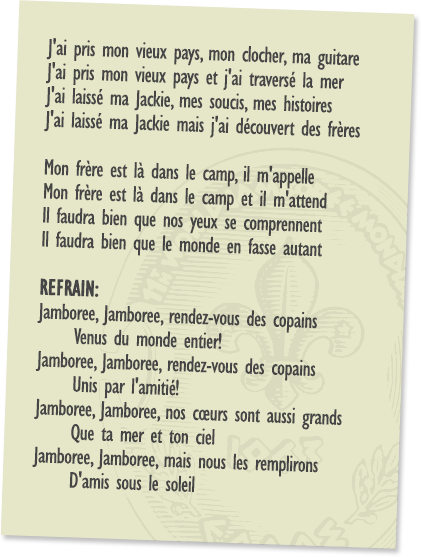
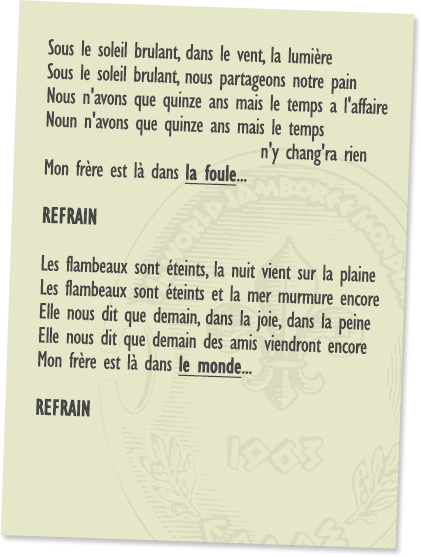


© Copyright 2013, marathon1963.com & proskopos.com. All rights reserved.
No part of the material contained in this website (images, texts, artwork) may be used or reproduced without
written permission or invitation by the publisher. Request permission to use or reproduce material.